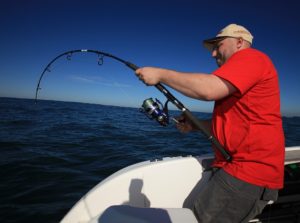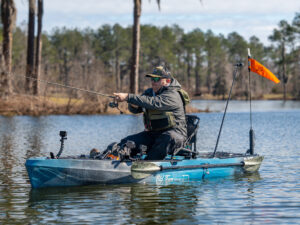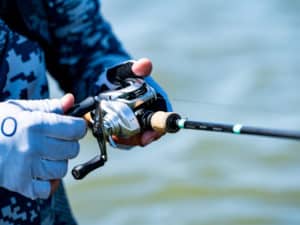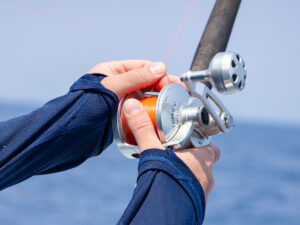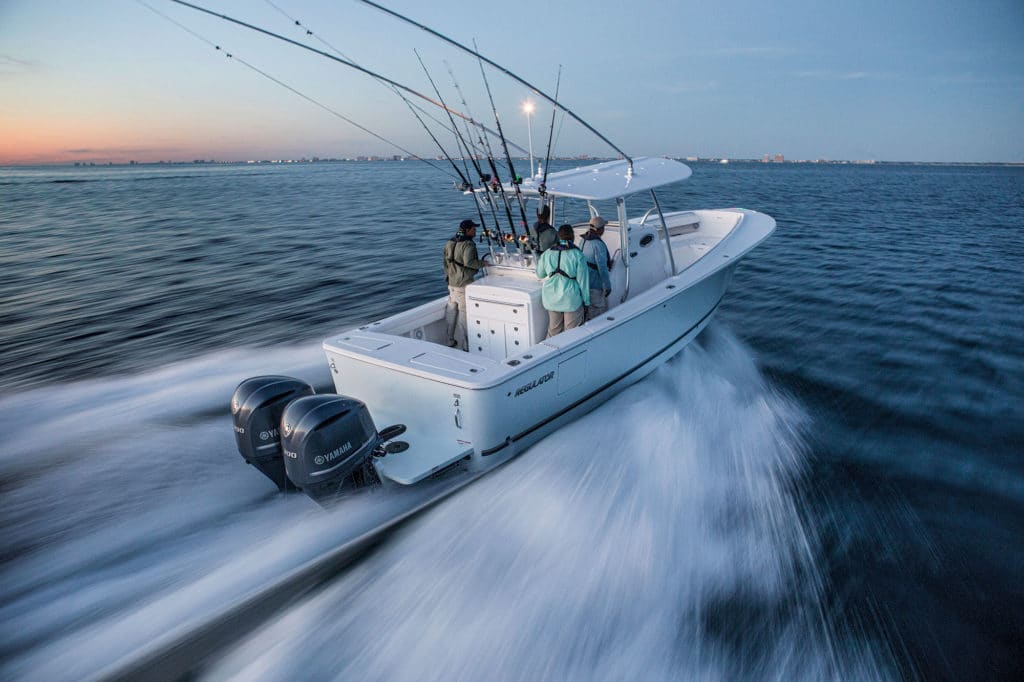
When everything runs correctly, an outboard engine is like a light switch: It’s one of those engineering marvels we take for granted. But just how does it work? How does it take fuel and turn it into power?
To answer that question and shed light on the latest innovations, I spoke with product managers for today’s most popular engine brands: Yamaha, Mercury, Suzuki, Evinrude, Honda and Seven Marine.
Two-Stroke Start
Until 1964, all outboard engines used two‑stroke, internal-combustion technology. A two-stroke engine completes its cycle with two piston movements—one up and one down—during one crankshaft revolution. A four-stroke requires four piston movements over two crankshaft revolutions.
“Said another way: A two-stroke delivers two times as many power strokes as a four-stroke,” says Larry Koschak, senior outboard product coordinator for Evinrude, which builds only two-stroke outboards.
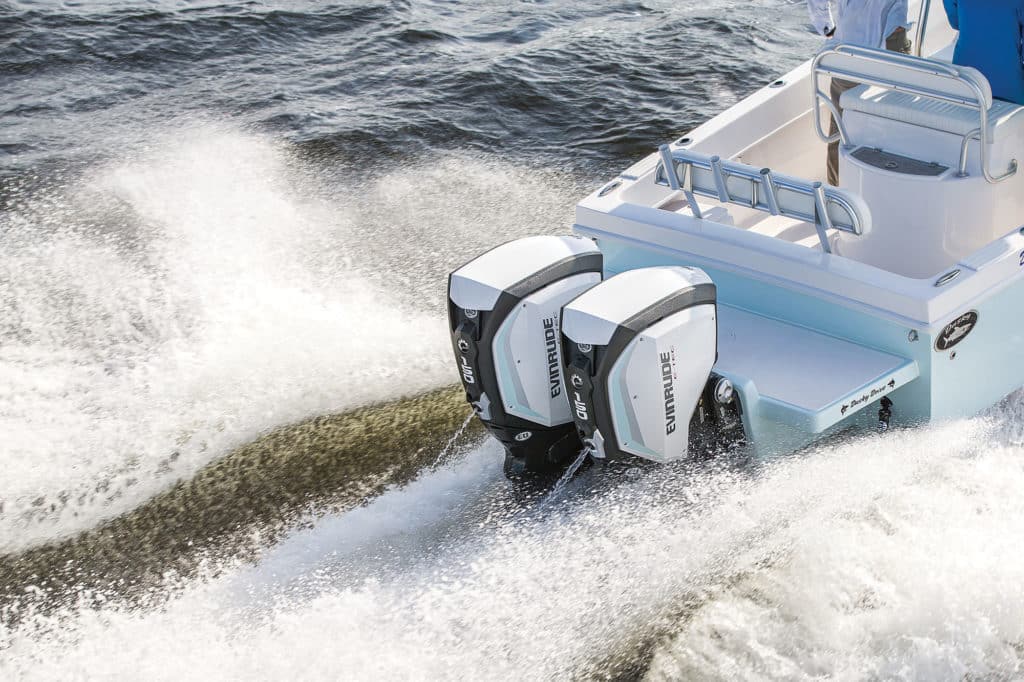
But in the mid-1960s, Honda introduced the first four-stroke outboard. “Our founder, Soichiro Honda, felt strongly that four-stroke engines are a cleaner technology for the environment,” says Davis Adams with Honda public relations.
Early four-strokes did prove cleaner and quieter, but they were heavier and slower than two-strokes of comparable horsepower.
Five decades later, both technologies have advanced on all fronts, like a powerful, mechanized army. The two-versus-four debate continues, with each side making a new case for superiority, based on maintenance, reliability, power, fuel efficiency and emissions.
For instance, Koschak says the rate at which engines achieve and build horsepower is called the power curve.
Two-strokes build power more quickly to jump on plane faster. They also employ fewer working parts, use fresh oil for lubrication, and don’t need oil changes. Two-stroke outboards built for the US market also employ direct injection, which fires fuel directly into the combustion chamber after the intake and exhaust valves’ ports have fully closed.
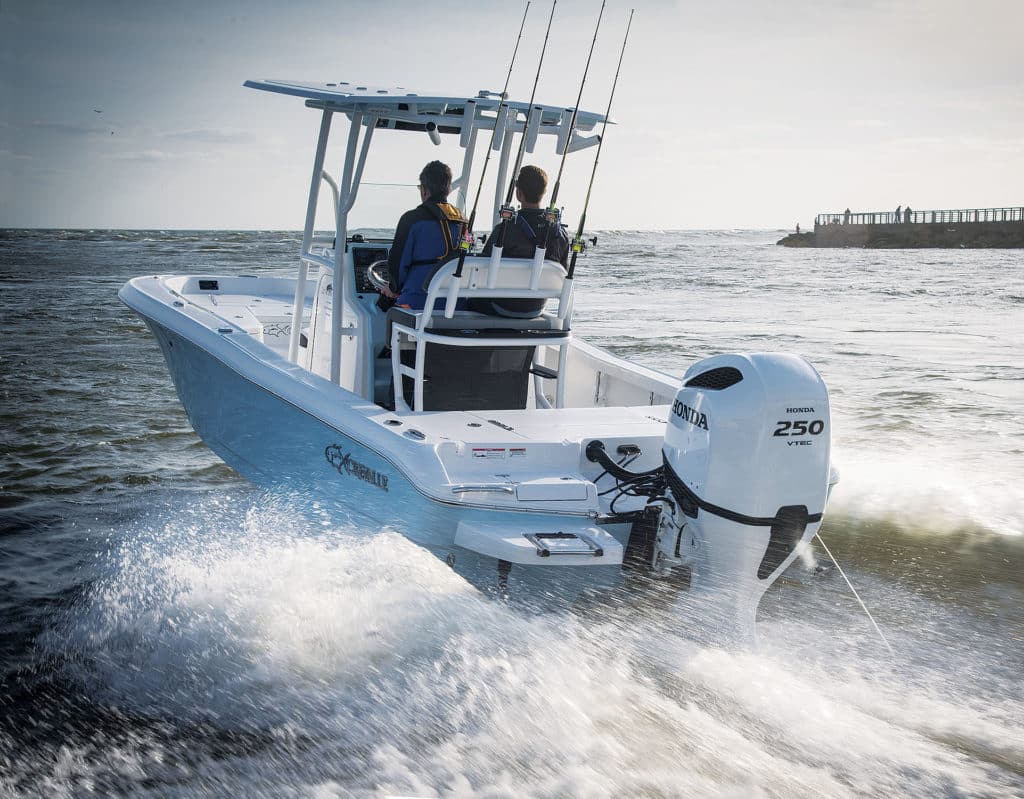
Most four-strokes, with the exception of Yamaha’s new 425 XTO (the first four-stroke to use DI), employ electronic fuel injection, which introduces fuel to the intake runner just above the valve and times each injection to coincide with the valve opening.
“It’s only a slightly less efficient—though much less costly—way of doing things” compared with direct injection, says David Meeler, Yamaha’s marine-product-introduction manager.
Beyond the debate, the fact remains: The majority of outboards—some say as much as 90 percent—use four-stroke technology. For the purpose of explaining how outboards work, I’ll focus on four-strokes.
Outboard Anatomy
Most anglers have probably heard the terms used to describe outboard sections: cowling, powerhead, midsection, lower unit and propeller. Here are some basic definitions:
Cowling: The top outer covering of the outboard, often made from sheet-molding compound. “It’s basically sheeting of varying lengths, thicknesses and polymers that is heated, and then compressed by a gargantuan press that molds it into the shape you see,” Meeler says. The cowling protects the engine, quiets engine noise, and is designed with ports where air can enter the system. More air equals more power.
Powerhead: The upper portion of the outboard, where power is made via the combustion process, and where the engine-control unit, or ECU, calculates such things as air and fuel mixtures and precise timing. In a four-stroke, the cylinder configuration can be inline, which simply means multiple cylinders in a straight line, or V-type, meaning the cylinders are grouped into pairs and arranged in a V angle.
Midsection: The middle portion of the outboard containing the oil pan, exhaust housing, water tube (which brings cooling water up from the lower unit), upper driveshaft (which allows the energy from the pistons to transfer circular motion to the lower unit) and bracket.
Lower Unit: Contains the lower driveshaft and prop shaft, the gears of which mesh to spin the propeller. Atop this is the water pump. The lower unit is terminated by a skeg, which acts like a rudder.
Propeller: Pushes against the water to move the boat. Today’s props for saltwater outboards, generally made from stainless steel, come in many sizes and designs, and are specifically matched to the outboard’s power and weight and the boat’s performance needs.
Basic Process
Complicated subjects can often be broken down into manageable thoughts. And while outboard-engine tech is a next-level skill beyond the reach of many, most of us can grasp the logical progression when it’s visualized as a drop of fuel entering the combustion process.
Yamaha’s Meeler walked me through the steps that a fuel drop takes in an F300 four-stroke outboard. Those steps are represented in the outboard-cutaway graphic below.
When you realize that this process happens 100 times per second (at 6,000 rpm), he says, you can begin to see the modern miracle behind our boating and angling enjoyment.
Moving Forward
What does the future hold and how have these processes improved during the past 30 years? Outboard-makers point to a wide assortment of technological changes.
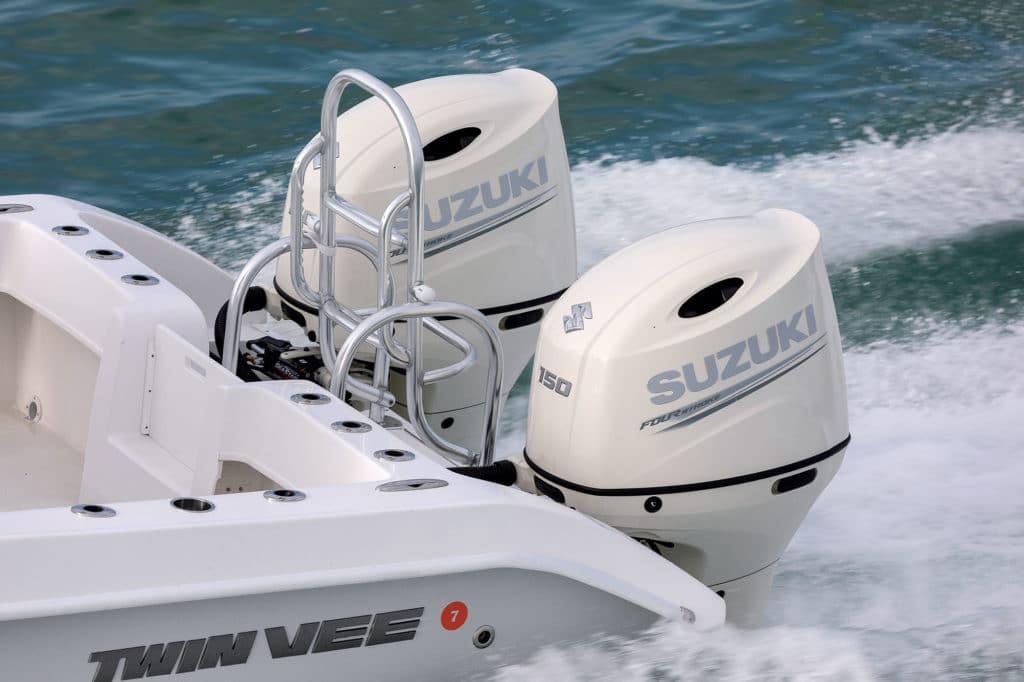
Four-stroke outboards continue to evolve toward becoming lighter and more fuel-efficient, says Gus Blakely, Suzuki’s marine vice president of sales. “Suzuki pioneered having two fuel injectors per cylinder, which keeps the fuel cooler and delivers it at the precise time it’s needed into the cylinder,” he says. “Cooler fuel and cooler, denser air results in more efficient combustion and produces more horsepower.”
Suzuki also has recently introduced contra-rotating twin props on its 350 and 300 four-strokes for 2020. “You can increase the horsepower as much as you want; the prop will always be a limiting factor in performance,” Blakely says. Among its advantages, “contra-rotating props provide superior grip on the water when you hit the throttle for excellent hole shot and acceleration.”
ECUs also have improved with more-powerful processors, he adds, juggling the critical timing of fuel delivery, air delivery and ignition.
Honda cites its intelligent throttle and shift command-and-control system for V-6 outboards. The system offers “fine-tuning of throttle settings at any speed, enhanced docking and slow-speed control, return-to-port capability, and effortless shift-and-throttle control,” Adams says.
Read Next: New Outboard Engines Spur the Rise of Single-System Boats
Future outboards should mimic the capabilities of land-based computer and communication technologies, creating complete systems that provide seamless control from the helm. We’ve already seen developments such as Yamaha’s Helm Master and Mercury’s Joystick Piloting, as well as Mercury’s partnership with Raymarine for DockSense.
And with Yamaha’s introduction of true electric steering in the 425 XTO, four-strokes have met another challenge.
“When you turn the wheel, it’s sending commands directly to a steering actuator, not to a pump that then has to move hydraulic oil,” Meeler says. “That was a wow.”
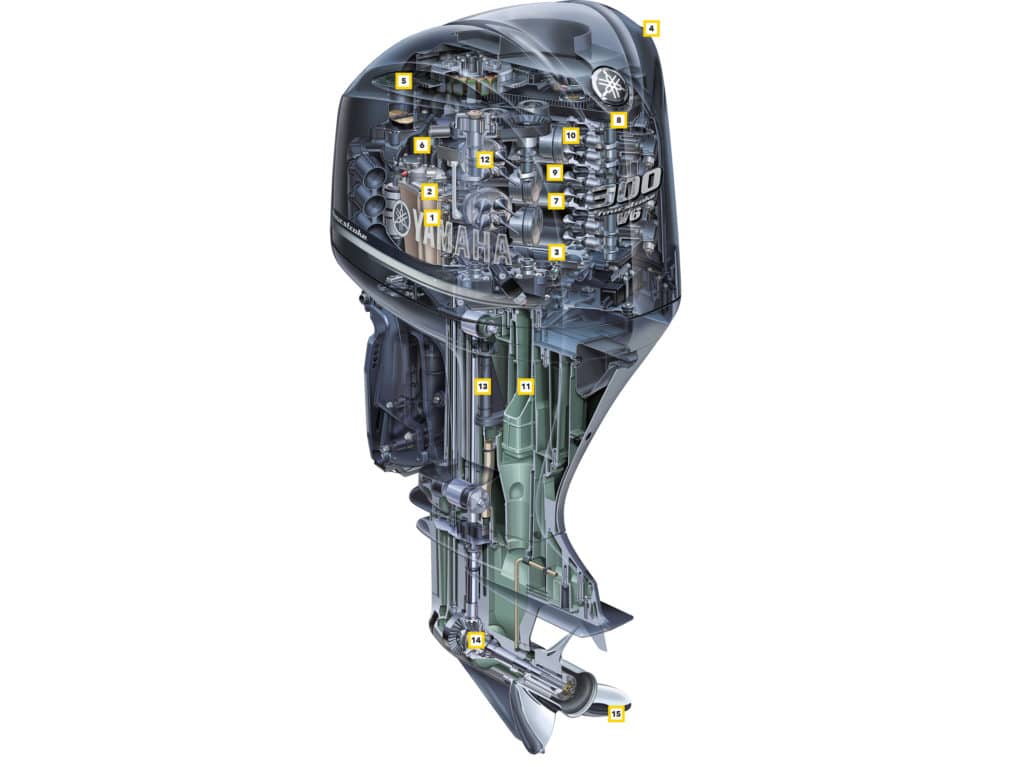
1. A drop of fuel is drawn out of the boat tank and through a 10-micron water-separating fuel filter in the boat by the cam-driven, lower-pressure fuel pump. It then passes through a smaller, on-engine 10-micron water-separating fuel filter before being deposited into the Vapor Separator Tank.
2. The job of the VST is to separate any air from our pure drop of fuel, then send the fuel through an electric, medium-pressure pump to the fuel rails.
3. Meanwhile, the intake stroke of each piston creates a constant vacuum that draws air into the engine.
4. Air enters through the openings in the cowling and is passed through a labyrinth of passages. This causes any water, which is heavier than the air, to fall to the bottom, where it is drained from the cowling back to the sea.
5. Air enters the intake, and is measured for temperature, pressure (altitude) and volume (via the throttle-position sensor). This vital information is passed to the outboard’s engine-control unit while the air enters specially engineered long-tube intake tracks that accelerate it on its way toward the combustion chamber.
6. The ECU uses the information about the air and data from other vital sensors such as the throttle-position sensor (how much power the operator is demanding) and the crank-position sensor (how fast the engine is running) to determine how much fuel to spray into each cylinder for optimal power and best fuel economy given the current conditions and operator request.
7. Our drop of fuel is turned into a fine mist by the pressurized fuel injector and sprayed into the intake, just above a cylinder’s intake valve, in the exact amount needed to mix properly with the air charge coming down the intake track. The amount and timing is exactly determined by the outboard’s ECU.
8. If the operator is asking for a lot of power fast (such as sudden acceleration), the ECU sends engine oil through a special valve that accelerates the opening of the intake valve, allowing the fuel and air to charge in sooner, creating a strong burst of power. This is Yamaha’s Variable Camshaft Timing system and accounts for that kick‑in-the-pants feeling when you hammer the throttle.
9. The intake valve closes, and the piston compresses the fuel/air mixture. At the exactly correct moment, the ECU commands the spark plug to light the fuel/air mix, and a controlled and contained explosion pushes the piston back down.
10. At this point, our drop of fuel, along with its partner charge of air, has done its job by releasing the energy needed to move the crankshaft, and is summarily dismissed from the combustion chamber by the rising piston through the now-open exhaust valve.
11. The engine’s exhaust from all the cylinders becomes a flow that exits the engine through a water-cooled exhaust housing in the outboard’s midsection, then out through the hollow passage inside the propeller’s hub area.
12. Meanwhile, the energy created by our drop of fuel and its partner air charge, once burned and rapidly expanded in volume, rotates the crankshaft…
13. …which rotates the driveshaft…
14. …which rotates the gears in the lower unit…
15. …which rotates the propeller, which pushes the water, which pushes the boat.
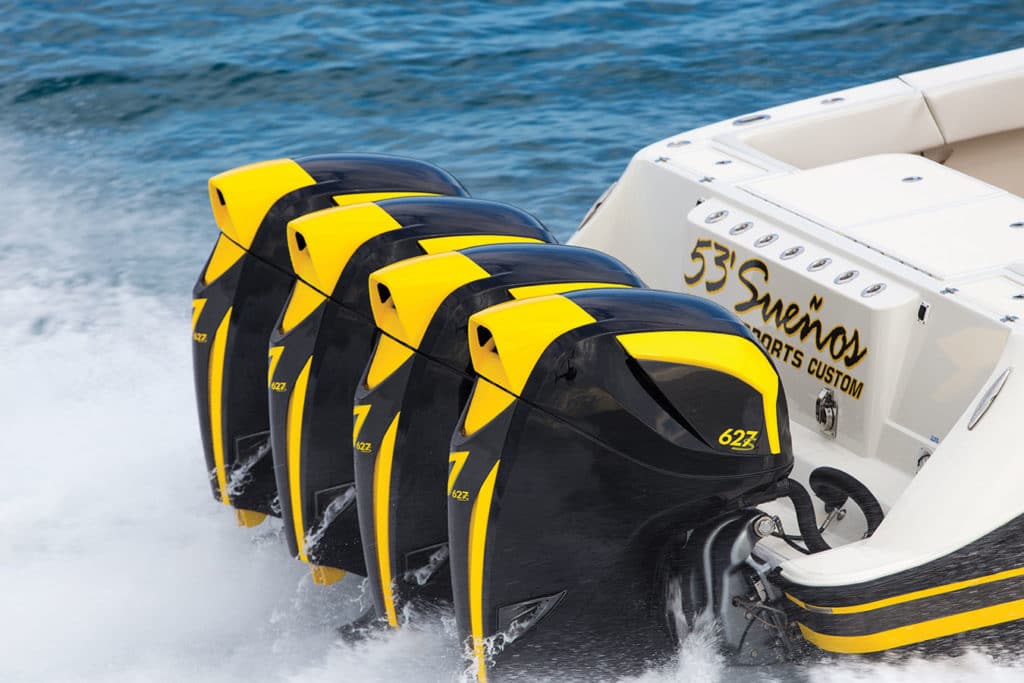
High-Powered Horses
Seven Marine jumped into the four-stroke-outboard market on the super-high end of the horsepower spectrum, first with its 557 hp engine in 2011, and later with its 627. First deliveries began in 2013.
“What we saw was that the limit of the outboard-powered boat was the horsepower available from four-stroke outboards. If boats have four of the max-powered motors, then larger-horsepower motors would allow the market to expand in the boat offerings,” says Brian Davis, vice president of Seven Marine.
He says that the company, now owned by Volvo Penta, leverages automotive-based engines to deliver more torque and power than other outboards. New hydraulic transmissions create smoother shifting, and—to reduce service costs—Seven uses closed cooling technology, which keeps salt water out of the powerhead.
Seven offers both single-prop and duoprop (contra-rotating props) lower units to customize each outboard to a boater’s needs. Add to that spectacular aesthetics—including LED lighting and multiple colors—and these outboards easily pair with the current, and rapidly expanding, luxury center-console boat market.
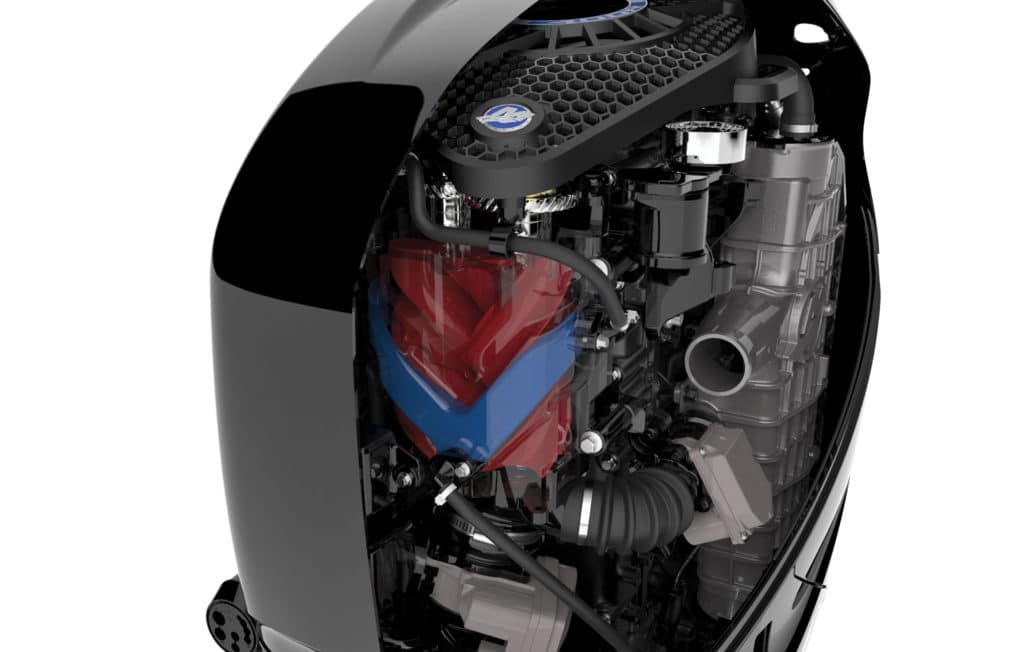
Naturally Aspirated vs. Supercharged
Boating anglers often hear the terms “naturally aspirated” and “supercharged” with regard to outboard power. But what do those terms mean, and how do those technologies affect the way engines work?
Mercury introduced the first supercharged four-stroke outboard in 2004 with its Verado lineup; Seven Marine also uses the technology. On the other hand, Mercury recently debuted a new line of naturally aspirated four-strokes, including the 4.6-liter V-8 300. The rest of the market primarily uses natural aspiration.
D.J. Belter, director of engine design and analysis for Mercury, uses this example: If you take a syringe and pull back the plunger, it will draw in air—that’s analogous to natural aspiration. Now, imagine pulling back the plunger while at the same time blowing air into the syringe—that correlates to supercharging.
“A supercharger is nothing more than a mechanically driven air pump that blows air into the combustion chamber when the intake valve opens and the piston is traveling down the bore,” he says.
“The oxygen in the air is needed for the combustion process, so the more air you can cram into the combustion chamber, the more power you can make.”

